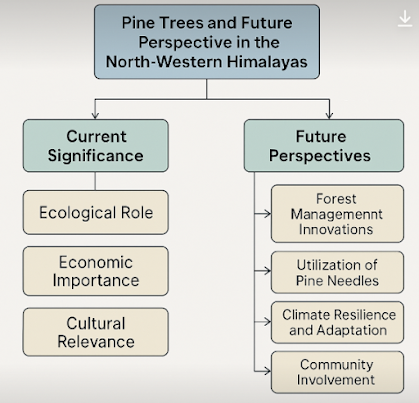Pine Trees and Future Perspective in the North-Western Himalayas
Pine Trees and Future Perspective in the North-Western Himalayas
The North-Western Himalayas, comprising states like Himachal Pradesh, Uttarakhand, and parts of Jammu & Kashmir, are home to extensive pine forests, particularly Chir Pine (Pinus roxburghii). These conifers are not only ecologically significant but also economically valuable. However, their role in the region is under increasing scrutiny due to environmental, social, and climatic changes.
Current Significance
-
Ecological Role:
-
Stabilizes fragile mountain soils.
-
Acts as a pioneer species in degraded landscapes.
-
Provides habitat for wildlife and supports biodiversity indirectly.
-
-
Economic Importance:
-
Resin extraction is a major livelihood activity.
-
Pinewood is widely used for timber, fuelwood, and construction.
-
Pine needles can be utilized for making briquettes and biodegradable products.
-
-
Cultural Relevance:
-
Integral to the traditional livelihoods of hill communities.
-
Sacred and symbolic in many local traditions.
-
Challenges
-
Fire Hazard: Pine needles are highly inflammable, leading to frequent forest fires, especially during dry summer months.
-
Invasive Expansion: In some areas, pine is replacing broad-leaved forests like oak, affecting water retention and soil quality.
-
Climate Change: Altered precipitation and temperature patterns are impacting natural regeneration cycles and making pine forests more vulnerable to pests and diseases.
Future Perspectives
-
Forest Management Innovations:
-
Promote mixed plantations with broad-leaved species to improve biodiversity and fire resistance.
-
Encourage sustainable resin tapping practices.
-
-
Utilization of Pine Needles:
-
Develop cottage industries around pine needle-based products to reduce fire risk and create employment.
-
Government schemes can incentivize collection and use of needles for bioenergy.
-
-
Climate Resilience and Adaptation:
-
Breed drought- and pest-resistant varieties of pine.
-
Monitor ecological shifts using remote sensing and GIS to adapt management strategies.
-
-
Community Involvement:
-
Involve local communities in forest governance and benefit-sharing schemes.
-
Promote eco-tourism and pine forest conservation awareness.
-




Comments
Post a Comment